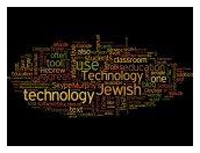Adrian A. Durlester
Today’s Technology Tips:
 Wordle (http://www.wordle.net) Many of you may already be using this amazing tool. What is does is produce a graphic representation of the text content of a document, using relative size and placement based on the frequency of occurrence of each word. The output is highly customizable. The results are often a great conversation starter. While Wordle even self-describes itself as a toy, it is actually a sophisticated textual analysis tool. For ideas, Google using wordle in the classroom. You can use Hebrew text in Wordle as long as it is in a Unicode font. What’s a Unicode font? RTFM.
Wordle (http://www.wordle.net) Many of you may already be using this amazing tool. What is does is produce a graphic representation of the text content of a document, using relative size and placement based on the frequency of occurrence of each word. The output is highly customizable. The results are often a great conversation starter. While Wordle even self-describes itself as a toy, it is actually a sophisticated textual analysis tool. For ideas, Google using wordle in the classroom. You can use Hebrew text in Wordle as long as it is in a Unicode font. What’s a Unicode font? RTFM.
Smart-Phone Flash Cards. There are a number of smartphone flashcard apps available for iPhone and Android phones. There are also alef-bet flashcards available for both platforms. (While there are web-based flash card sites that allow you to create your own Hebrew flash cards, I’ve yet to find an Android or iOS flash card app that works with Hebrew. If you know of one, let us know!) Flash cards are another great way to leverage smart phone use in service to Jewish education.
My Go-To Blogs: There are lots of people out there blogging about technology in Jewish education. Here are some of my favorite sources for new ideas and new technologies.
Muse for the Jews http://museforjews.com/. This is the blog of Debbie Harris, technology coordinator at the Sager Solomon Schechter Middle School in Northbrook, IL. Her most recent post is about the many ways you can use Google Docs.
The AVI CHAI Foundation Educational Technology Blog http://edtechexp.blogspot.com/ is aimed at day schools, but is useful reading for anyone involved in Jewish education.
Tech Rav http://techrav.blogspot.com/ is Rabbi Tzvi Pittinksy, Director of Education Technology at the Frisch School, a Jewish HS in Paramus, NJ.
You can find the blogs for the DarimOnline folks, Lisa Colton and Caren Levine, at http://www.etheoreal.com/jlearn2.0/ and http://jewpoint0.org/.
Glogster.com http://edu.glogster.com/ is a site for creating interactive posters. The folks at Glogster have created a special are for educational uses. You can sign up for a free single teacher account allowing for up to 50 students (higher levels have a monthly or annual fee.) A Glog is an interactive poster created from text, images, music and video, as a form of self-expression. Educational glogs can be individual or collaborative works. Glogster is a great opportunity to co-opt contemporary pop culture in service to education. Do be aware that the free basic educational version does not offer as full and complete control over what the students do as the premium versions, so use with caution. You can try the premium version free for 30 days.
Skype can be a powerful classroom tool as well as one for individual instruction. Using Skype you can set up real-time interactive interviews between your class and that scholar/survivor/author/resource that you’re unable to physically bring into your classroom for whatever reason. (A great tool for teacher professional development, too!) Here’s a link to a blog post on one teacher’s experiences with turning Skype Calls into Learning Calls http://tinyurl.com/6ezvwcn
Helping people utilize technology isn’t just about teaching them about the tools. As with any endeavor you have to examine philosophies, ethics, realities and all sorts of other factors if you want your pedagogy to be efficacious. So, in addition to offering tips about the technology itself, I also want to include some theory, practical advice, and cautions.
Murphy’s Law and New Technology. This one is pretty simple. Don’t attempt to use a new technology (or even something as seemingly innocuous as an unfamiliar feature of some software which you otherwise use regularly at the last minute. Murphy’s Law is in operation here. In addition, the more desperately you need it to work, or the more last minute you are, then the effect of Murphy’s Law increases. It may seem like common sense, but trust me I’ve seen lots of folks (yours truly included) get caught in this trap.
RTFM—Read the (expletive) manual. Lose that pride and ego, and just do it. For students, I often describe the Torah as an instruction manual on how to be a good human being. I often imagine G”d answering our questions with a simple RTFT. You wouldn’t attempt to be Jewish without reading the Torah, would you? Treat technology with similar respect.
As a brief corollary to the above I would add you should always also read those “release notes” and other addenda that come with software, applications, devices, and updates.
Need more information, some hand-holding, translation of techo-jargon? Have a resource you’d like to share? You can reach me at my contact points for my Technology in Jewish Education consulting work: e-mail yoeitzdrian@durlester.com. Twitter @yoeitzdrian. Adrian A. Durlester adrian@durlester.com (413) 570-0223 or www.durlester.com Migdalor Guy’s Blog.

